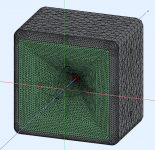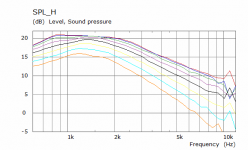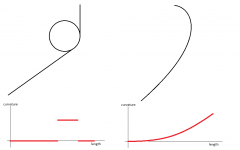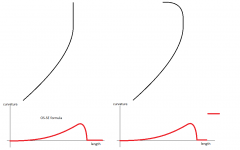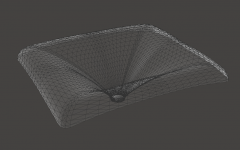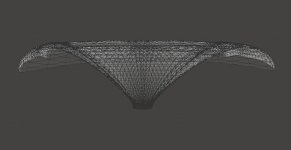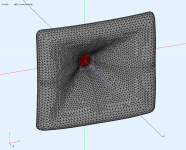No I didn't, but here is the same waveguide curve forced to rectangular in an enclosure, I don't think anyone would argue this is better than the round one. Rectangular can work well but the overall enclosure needs to be tuned to work with it rather than against it as seen here. The diffraction in this one is low but it does not have a lot of extra asymmetric baffle to it either.Didn't Fluid basically show that a rectangular waveguide in a baffle with large roundovers behaves similarly as a free standing rectangular waveguide with rollback termination? That's not the same thing as a round waveguide in a rectangular baffle. It does seem desirable to me to design the shape of the waveguide according to how / where it will be used. I.e. rectangular if it's to end up as part of a baffle and reserve round / elliptical for free standing.
Attachments
Last edited:
Just to be clear in case what I posted was confusing, the waveguide designed to terminate flat was not much different in a small baffle with edge roundover to the same waveguide with a 50mm roundover added straight to the guide, but the size and shape of the whole enclosure can have a strong effect on the fully baffled version and this can be hard to predict without running a full 3D simulation.Am I mistaken or did Fluid show that the difference between free standing and baffle were not very great?
What is better than either of those is a freestanding guide with the curvature optimized over the whole length with the rollback feature but because of how that changes the shape it is almost impossible to make a true side by side comparison as you have to change parameters when adding the rollback to get the desired response.
Nor had I before I started doing these simulations but the effect can be quite strong and not always good.And I had not thought about the depth of the enclosure.
Thanks for clearing that up, I had indeed misread. And reading it again it was actually quite clear in the first place.
And it seems that the flat surfaces that exist, when placing a non-rectangular waveguide in a baffle are negligible as long as the baffle ends with a roundover at the tangential points?
And it seems that the flat surfaces that exist, when placing a non-rectangular waveguide in a baffle are negligible as long as the baffle ends with a roundover at the tangential points?
Are there any budget options for going low that are less than the HF1440? Even if it sacrifices top end, which I don't rank as important as others.
This one goes lower, costs less than half of the HF1440, but it doesn't make it to 20k.
It's kind of a hidden gem if you ask me.
Last edited:
How does one even tell how low these actually go? Because the recommended XO points are high, I guess because they are rated for PA use....
i would contact Q Components and see if it could be ordered, they are Beyma dealers.
Thanks for the tip!
How does one even tell how low these actually go? Because the recommended XO points are high, I guess because they are rated for PA use....
I have received 'first hand' confirmation that this driver can be used from 700 Hz and I am confident that it can be used from 600, or even 500 Hz with a suitable horn.
Last edited:
If that is a mathematical way of saying keep the baffle as small as practically possible then yes, providing the dimensions of the rest of the enclosure don't muck it up somehow 🙂And it seems that the flat surfaces that exist, when placing a non-rectangular waveguide in a baffle are negligible as long as the baffle ends with a roundover at the tangential points?
All I would say is that you seem to want to go by a rule so you can order things in your mind. Unfortunately the level of interaction between all the possible options makes this a fools errand that at some point will be shown not to work.
Last edited:
No, I mean specifically change of curvature. From my observations a gradual change of slope (i.e. mere continuity of the first derivative) is not enough. All the unprecedented smoothenss of the newest free standing waveguides is achieved (IMHO) by a gradual change of curvature. This is an illustration of what I'm talking about (not to scale, it's a hand drawn sketch) - parts of two different terminations:Are you mixing up "curvature" with "slope"?
Attachments
If that is a mathematical way of saying keep the baffle as small as practically possible then yes, providing the dimensions of the rest of the enclosure don't muck it up somehow 🙂
All I would say is that you seem to want to go by a rule so you can order things in your mind. Unfortunately the level of interaction between all the possible options makes this a fools errand that at some point will be shown not to work.
Haha, my math is very limited, was just trying to be precise.
You’re definitely right about me trying to order things in my mind, but not necessarily by some hard rule. What I’m curious about here is I think similar to what mabat’s last few posts were about, or at least they got me started.
My thoughts were purely conceptual (and that might well be contradictory to the “interaction between all the possible options” you mention), but it does seem sensible to me to design a particular waveguide with its future environment in mind. In other words if I wish to mount it in a baffle, wouldn’t it make sense to take the shape and the roundovers of the baffle (both in their beneficial and detrimental qualities) into account rather than optimizing the waveguide on its own and then stick it in a baffle? And wouldn’t that lead to some sort of rectangularly shaped waveguide?
Earl seemed to disagree quite strongly, but I’m not sure whether because I was being unclear (rectangular might be the wrong word for example) or because he thinks that you inherently compromise the acoustic properties of the no longer axisymmetric waveguide and are bound to lose more than you could possibly gain.
Yes it does to me and I think they can be very good. Just because it can be done better in another way doesn't mean that a flat baffle termination is bad.it does seem sensible to me to design a particular waveguide with its future environment in mind. In other words if I wish to mount it in a baffle, wouldn’t it make sense to take the shape and the roundovers of the baffle (both in their beneficial and detrimental qualities) into account rather than optimizing the waveguide on its own and then stick it in a baffle?
To that I say no, while it could work better I don't see that it would inherently work better, look at the rectangular sim vs the round one from before. The round one has an extra bit of baffle in the corners but it's horizontal and vertical is better than the rectangular one with the roundover right on the edge of the waveguide. The diagonal might be less perfect.And wouldn’t that lead to some sort of rectangularly shaped waveguide?
This is the part where I think you have to take the entirety of the enclosure into account in a simulation to see the combined effect.
Also the simulations I did were quarter symmetry to save time which means that any baffle included is limited to a shape that is cut in quarters. Changing it to half symmetry opens up greater options but takes at least twice as long to solve but sometimes much more.
I think the word 'rectangular' might be wrong and confusing for what I'm trying to say. Is there a better word for something like a SEOS waveguide (regardless of their actual vertical vs horizontal proportion) where the elliptical or circular is abandoned and it is straight left/right/top/bottom but the corners remain 'round' so there's no actual edge?
Is there a best tradeoff-point for a shape on the path of morping a circle into a rectangle?
Is there a best tradeoff-point for a shape on the path of morping a circle into a rectangle?
No, I mean specifically change of curvature. From my observations a gradual change of slope (i.e. mere continuity of the first derivative) is not enough. All the unprecedented smoothenss of the newest free standing waveguides is achieved (IMHO) by a gradual change of curvature. This is an illustration of what I'm talking about (not to scale, it's a hand drawn sketch) - parts of two different terminations:
Could a freestanding Tritonia be given a rollback with the same curvature as your freestanding round one?
- Home
- Loudspeakers
- Multi-Way
- Acoustic Horn Design – The Easy Way (Ath4)
